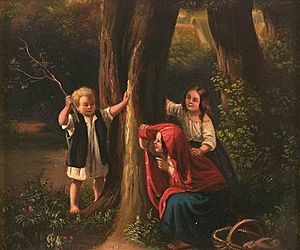Hide-and-go-seek facts for kids
Hide-and-seek (also called hide-and-go-seek) is a super fun and popular game that lots of kids play! It's a game where one person, called "it," closes their eyes and counts while everyone else hides. Once "it" finishes counting, they try to find all the hidden players. It's a great way to have fun with friends!
Contents
How to Play Hide-and-Seek
The game starts with one player being chosen as "it." This person closes their eyes and counts to a number decided by everyone, like 10 or 20. While "it" is counting, all the other players quickly find places to hide.
When "it" finishes counting, they usually shout, "Ready or not, here I come!" Then, "it" opens their eyes and starts looking for everyone.
Winning the Game
There are a few ways the game can end:
- Finding Everyone: In one common way, "it" tries to find all the hidden players. The last person found becomes "it" for the next round.
- Reaching Home Base: Another popular way involves a "home base." This is the spot where "it" counted. Hiders can try to sneak out of their hiding spots and race to touch the home base. If they touch it before "it" tags them, they are "safe." If "it" tags a player before they reach home base, that player becomes "it" for the next game.
Hide-and-seek is an example of an oral tradition. This means it's a game that children often learn from each other, passing it down through generations.
Different Ways to Play
People around the world play hide-and-seek with different rules and names. Here are some cool variations:
Sardines
In this version, only one person hides, and everyone else tries to find them. When a player finds the hider, they don't tell anyone. Instead, they hide with the first hider! Soon, more and more people are squished into the same hiding spot, like sardines in a can. The last person to find the group is the loser.
Calling Out Phrases
Sometimes, after "it" finds the first player, or if no one else can be found, "it" might call out a special phrase. A common one is "Olly olly oxen free!" or "All in, All in, Everybody out there all in free!" This tells all the other hiders that the game is over and they can come back to the home base for the next round. The original phrase was "All ye all ye, come for free."
Team Seeking
In some games, when a hider is found, they don't become "it." Instead, they join "it" and help look for the remaining hidden players. This makes the search faster!
Hide-and-Seek Tag
One fun variant combines hide-and-seek with tag. After all the hiders are found, the game turns into a game of tag. "It" chases everyone, and the first person they tag becomes "it" for the next round.
International Rules
- Australia: In some parts of Australia, the game is called "44 Homes." When "it" spots a hider, they shout, "Forty, Forty, I see you!" The hider then has to run to home base before "it" can tag them. If tagged, the hider becomes the new "it."
- India: In India, if a hider touches "it" and says "Dhappa," then "it" has to count again! But if "it" sees the hider before they can say "Dhappa," that hider becomes "it" next. Sometimes, hiders can just touch the spot where "it" was counting to say "Dhappa."
- Brazil and Russia: In these countries, "it" counts facing a wall. When "it" finds someone, both "it" and the hider race back to the counting spot. Whoever touches the spot first wins that round!
World Championship
Did you know there's a Hide-and-Seek World Championship? It's officially called the "Nascondino World Championship." "Nascondino" means hide-and-seek in Italian. This is a team competition for adults, and it started in 2010 in Bergamo, Italy.
The championship happens every year in Italy during the summer. It's played outdoors on a special field with both natural and artificial places to hide. In September 2017, the seventh competition took place with 70 teams from 11 different countries!
Images for kids
See also
 In Spanish: Escondite para niños
In Spanish: Escondite para niños



